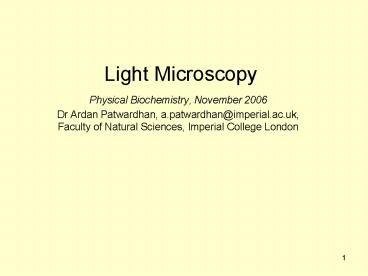Light Microscopy - PowerPoint PPT Presentation
1 / 24
Title:
Light Microscopy
Description:
Angular Magnification, M. Near point: shortest distance at which eye can accommodate (250mm) ... there is no limit to the magnification that can be attained! ... – PowerPoint PPT presentation
Number of Views:75
Avg rating:3.0/5.0
Title: Light Microscopy
1
Light Microscopy
- Physical Biochemistry, November 2006
- Dr Ardan Patwardhan, a.patwardhan_at_imperial.ac.uk,
Faculty of Natural Sciences, Imperial College
London
2
Snells Law
n refractive index of medium nair 1 nwater
1.33 noil 1.5 nglass 1.5
3
Thin lens equation
4
Special cases
5
The compound microscope
6
Angular Magnification, M
- Near point shortest distance at which eye can
accommodate (250mm) - M Angle (b) subtended by the image when viewed
through the microscope /angle (a) subtended by
the object when viewed by the naked eye both at
near point - In this case, Mm
- Using a suitable combination of lenses, there is
no limit to the magnification that can be
attained!!!
7
Factors limiting the smallest details that can be
seen in a microscope
- Optical ResolutionRayleigh resolution
criterion - Detector SamplingNyquist criterion
8
Resolution
- Rayleigh resolution criterion
Dx
q0
9
Rayleigh Resolution Criterion
10
Immersion lenses
11
Example
- Blue light l 400 nm
- Object in oil n 1.5
- Maximum possible angle sinq 1
12
Detectors Sampling
13
Less than two samples per cycle results in the
detection of a false signal (aliasing)
Two samples per cycle
Less than two samples per cycle
14
Sampling The Nyquist limit
- It is necessary to sample a sine wave at at-least
twice its frequency in order to be able to
reproduce it faithfully fsampling gt 2 fsine - Detector sampling may thus limit the overall
reproduction of detail rather than optical
resolution - Detector element spacing should be less Dx/2 of
the optical system (as projected onto the
detector plane)
15
Useful magnification
- Design constraints on the magnification of a
microscopea) The resolution of the optical
system should match that of the detectorb)
Field of view that is to be imagedc) Size of
image - For visual light microscopy, max useful is 2000X
16
Monochromatic lens aberrations
Spherical Aberration
Coma
Field Curvature
Distortion
Astigmatism
17
Chromatic Aberration
- Refractive index varies with wavelength !
- Depending on the solvent/embedding medium, can be
a significant problem
18
Specimen contrast
- Staining
- Phase contrast and differential interference
contrast (DIC) - Polarization microscopy
- Dark field
19
Phase contrast microscopy
- Useful for samples that do not absorb much, such
as unstained cells in an aqueous solvent - Due to variations in refractive indices and
thicknesses of different features, light will be
phase shifted by varying amounts over the
specimen - These phase variations are normally not visible
but can be made visible if the direct beam is
phase shifted by 90 relative to the diffracted
light - This can be achieved using a piece of glass of
appropriate thickness
20
Example of phase contrast
21
Polarization Microscopy
- Linear bifringence when the refractive index
depends on whether the linear polarization is
parallel or orthogonal to the optical axis - Often occurs in ordered specimens such as
crystals and muscle fibers - Is exploited in a polarization microscope by
using polarized light and an analyzer
22
Polarisation Contrast
- Muscle filament (A-band bright I-band dark)
- Biophys J. 1990 April 57(4) 815828
23
Dark field
- Oblique illumination of specimen
- Scattering from specimen imaged
- Scattering is at a maximum at interfaces between
different refractive indices
24
Conclusions
- Numerical Aperture NA nsin(?)
- Lateral resolution
- Highest lateral resolution 0.1 - 0.2 ?m in
object plane ? Cellular studies possible but not
at the molecular level ( at least not without
specific labelling)































